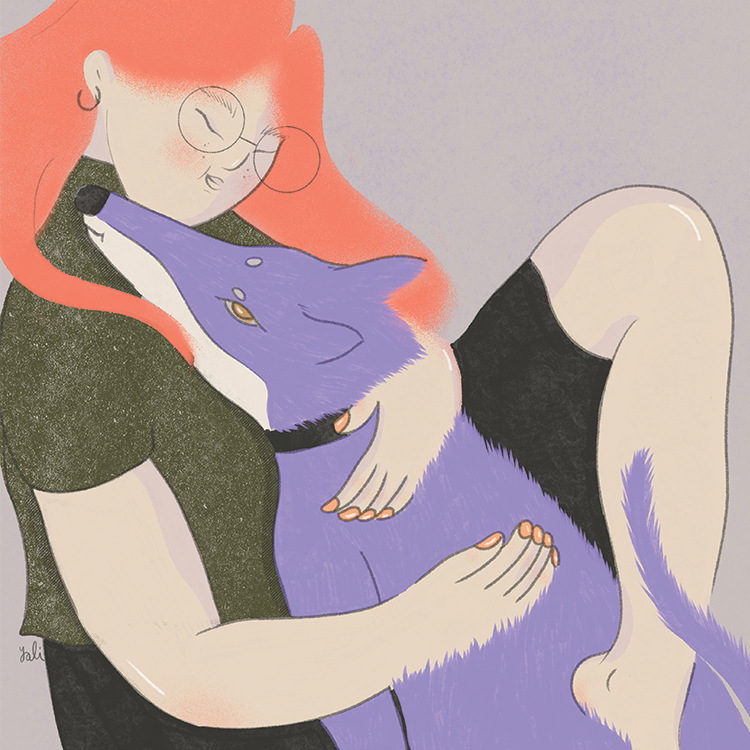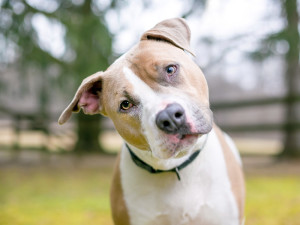Is That... Stress Your Dog Smells?
A study finds that your pup can tell – er, smell – when you’ve been doom-scrolling

share article
If you’ve ever tried to hide treats from your dog, you know they can sniff out chicken, steak, sausages, peanut butteropens in a new tab and even a small bit of biscuit stuck in the fold of your jumper. Trying to hide anything with an odour from our dogs is pointless. Turns out, one of those things is our stress, and yes, dogs can smell that, too.
Clara Wilson, an assistance and working dog researcher at Animal Behaviour Centre, School of Psychology in Belfast is the lead author of the 2022 studyopens in a new tab Dogs Can Discriminate Between Human Baseline and Psychological Stress Condition Odours in the journal PLOS ONE. “We wanted to answer a definitive question: can dogs tell the difference between two samples of breath and sweat from the same person before and after becoming stressed?” says Wilson.
She has a background in bio-detection dogs – the ones trained to search samples for human health conditions including cancer, Parkinson’s disease and Covid-19 – but notes: “whether dogs’ capabilities extend to detecting odours associated with psychological states has been explored far less.”
For the sake of science, the 36 people who volunteered to participate in the experiment wiped gauze over the back of their neck, put that gauze into a glass vial, and then exhaled into the vial before sealing it. Next, the experimenters purposefully stressed out the participants, who then put another sample of their sweat and breath into a different vial.
The source of the stress? Doing maths in public. Specifically, they were asked to count down out loud, from 9,000, by increments of 17, for three minutes without the use of pen and paper. If they gave a correct answer, nobody said anything, but they were called out for making a mistake. Bringing back memories of timed maths tests and making you sweat? Thought so.
The dogs in the study were pet dogs trained by the researchers to give an alert behaviour in response to the scent they were supposed to find. The alert behaviour – freezing above the correct sample or sitting down in front of it – allowed the dogs to communicate their ability to tell the odours apart. Wilson shares that she “became very close to the study dogs”, who were pet dogs volunteered by their owners from the local community.
The dogs had to choose the odour sample given by a person after experiencing stress from a set of samples that also included the baseline sample from that same person, and a ‘blank’ which was a vile containing the kind of gauze used to collect the samples. Based on chance alone – if the dogs were simply guessing – they should have identified the correct odour 33.33 percent of the time. In the experiment, they identified the correct sample 93.75 percent of the time. That means they can distinguish the odour of a person when they are feeling fine from the odour of that same person when they are stressed.
Wilson told The Wildest: “I was still surprised the first time the dogs were shown the pre- and post-maths task samples and confidently discriminated between them. I truly didn’t know if the dogs would interpret these smells as the same, as they had been taken from the same person within four minutes of each other, so it was fascinating to see how accurate the dogs were at discriminating between these odours when the only difference was that a psychological stress response had occurred.”
It’s wild to think that dogs can detect the difference in our body chemistry in stressed and unstressed conditions. “Confirming an odour component to psychological stress may raise further discussion into scent-based training for PTSD or psychiatric service dogsopens in a new tab, who are currently often trained to respond to visual signs of distress,” says Wilson.
It makes sense to train dogs to offer soothing behaviours in response to odours associated with stress. Possibilities include asking for strokes, offering physical contact, initiating play or asking to go for a walk. According to Wilson, training service dogs to respond to odour “could also enhance the reaction time of the alert, if the dog is able to respond to the initial onset of the stress response, as opposed to visual signs of distress that may come minutes later.”
Wilson believes “more research is needed on dogs’ ability to discriminate between different emotions, such as stress, fear, and excitement”. Luckily, she will continue to have the best partner she could ask for as she continues her work. “I have a very sweet Red Fox Labrador called Eddie, who is four years old. He loves to do scent games and is a good sport when I want to try out new training ideas or concepts for future discrimination paradigms at home.“
References:

Karen B. London, PhD, CAAB, CPDT-KA
Karen B. London, Ph.D., is a Certified Applied Animal Behaviorist and Certified Professional Dog Trainer who specializes in working with dogs with serious behavioral issues, including aggression, and has also trained other animals including cats, birds, snakes, and insects. She writes the animal column for the Arizona Daily Sun and is an Adjunct Professor in the Department of Biological Sciences at Northern Arizona University. She is the author of six books about training and behavior, including her most recent, Treat Everyone Like a Dog: How a Dog Trainer’s World View Can Improve Your Lifeopens in a new tab.
Related articles
![profile portrait of grumpy a ginger dog, inside on a golden retro velvet armchair]() opens in a new tab
opens in a new tabYour Grumpy Dog Is Very Smart – Science Says So
This study found that cranky pups are actually very fast social learners
- opens in a new tab
Are All Your Silly Nicknames for Your Dog Confusing Them?
I’m baffled by the number of names I call my dog. Is my dog baffled, too?
![black and white Corgi puppy eating out of a yellow dog bowl]() opens in a new tab
opens in a new tabCould Your Dog’s Diet Be Changing Their Behaviour?
It turns out the saying ‘you are what you eat’ isn’t just for humans
![Boy reading a book on the sofa to his dog]() opens in a new tab
opens in a new tabWhat Happens When Kids Read Books With Dogs
Spoiler alert: it’s more than just cute
- opens in a new tab
No Your Dog Does Not Feel Guilt – Here’s What Those ‘Regretful’ Looks Really Mean
Your pup doesn’t actually feel bad about eating your pizza
- opens in a new tab
Do Dogs Understand Our Words?
Say what? A look at the types of words that dogs understand








